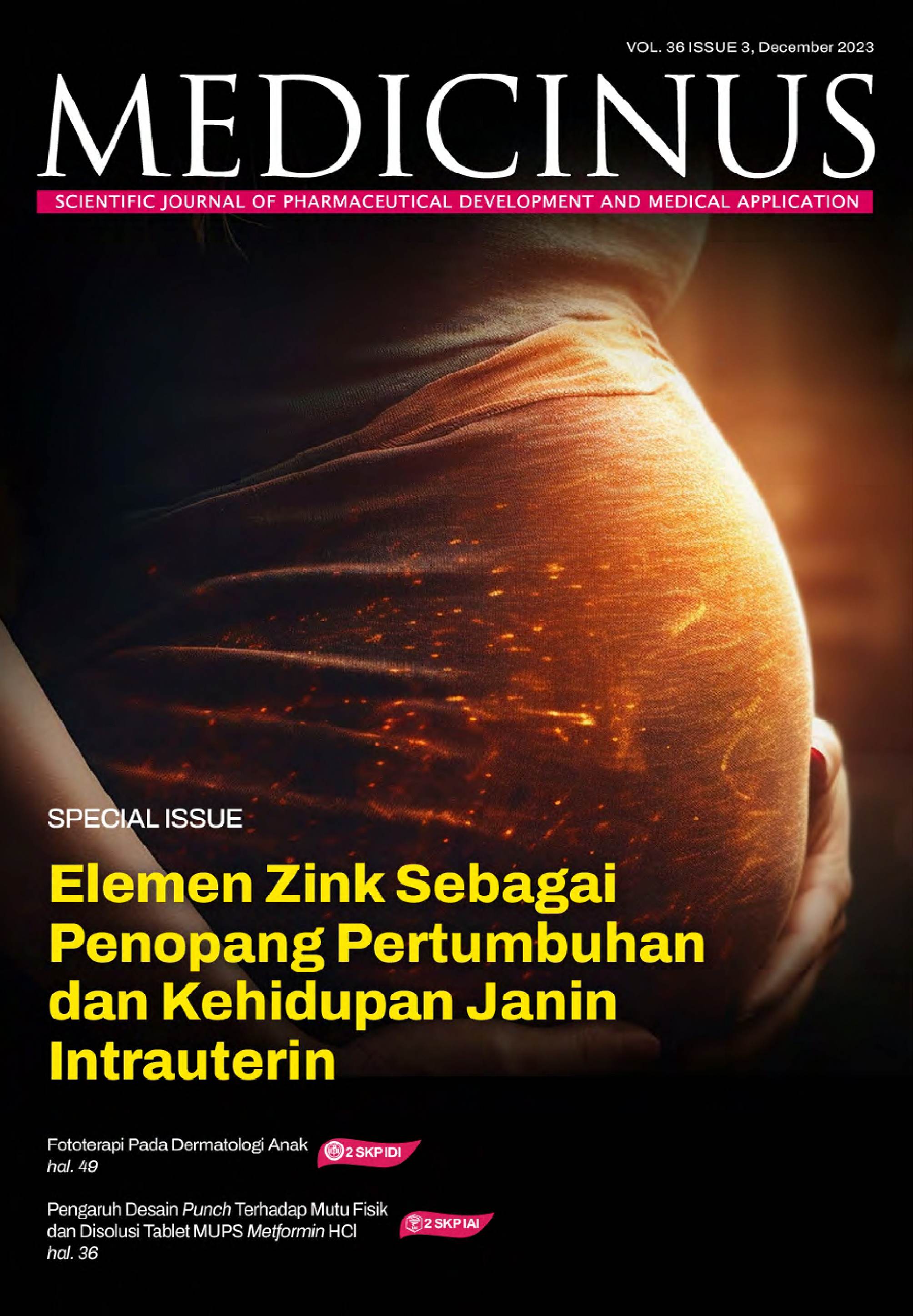Terapi Zink Oral pada Vitiligo
DOI:
https://doi.org/10.56951/g52hfk35Kata Kunci:
antiapoptotik, antioksidan, vitiligo, zinkAbstrak
Latar belakang: World Health Organization (WHO) memperkirakan sekitar 2 miliar dari seluruh populasi dunia mengalami defisiensi zink. Manifestasi klinis dari defisiensi zink di antaranya adalah disfungsi sistem imun, serta peningkatan stres oksidatif dan sitokin inflamasi. Stres oksidatif merupakan salah satu faktor yang berperan penting terhadap berbagai penyakit autoimun, salah satunya vitiligo. Diskusi: Vitiligo adalah penyakit depigmentasi yang paling sering dijumpai, yang disebabkan oleh kerusakan melanosit dan memberikan gambaran klinis berupa makula serta bercak depigmentasi pada kulit dan mukosa. Pengobatan vitiligo masih merupakan suatu tantangan dan berbagai modalitas terapi yang tersedia memberikan hasil yang bervariasi. Zink merupakan salah satu mikronutrien dan antioksidan yang berperan sebagai antiapoptotik dengan cara memengaruhi proses melanogenesis serta eliminasi radikal bebas. Zink diduga menghambat stres oksidatif dan mencegah kerusakan melanosit sehingga dapat dipertimbangkan sebagai salah satu terapi alternatif pada vitiligo. Kesimpulan: Zink bersifat antiapoptotik yang dapat dipertimbangkan sebagai terapi tambahan pada pasien vitiligo.
Unduhan
Referensi
Yan A. Cutaneous changes in nutritional disease. Dalam: Kang S, Amagai M, Bruckner A, Enk A, et al., editor. Fitzpatrick’s Dermatology. Edisi ke-9. New York: McGraw Hill Companies; 2019. h.2224-6.
Prasad A. Zinc is antioxidant and antiinflammatory agent: its role in human health. Front Nutr. 2014;1(14):1-10. DOI: https://doi.org/10.3389/fnut.2014.00014
Prasad A, Beck F, Bao B, Fitzgerald J, Snell D, et al. Zinc supplementation decreases incidence of infections in the eldery: Effect of zinc on generation of cytokines and oxIdative stress. Am J Clin Nutr. 2007;85(3):837-44. DOI: https://doi.org/10.1093/ajcn/85.3.837
Alikhan A, Felsten L, Daly M, Petronic-Rosic V. Vitiligo: a comprehensive overview. Part I. Introduction, epidemiology, quality of life, diagnosis, differential diagnosis, associations, histopathology, etiology, and work-up. J Am Acad Dermatol. 2011;65(3):473-91. DOI: https://doi.org/10.1016/j.jaad.2010.11.061
Kumar S, Nayak C, Padhi T, Rao G, Rao A, et al. Epidemiological pattern of psoriasis, vitiligo and atopic dermatitis in India: Hospital-based point prevalence. Indian dermatol Online J. 2014;5(1):6-8. DOI: https://doi.org/10.4103/2229-5178.144499
Lukas R, Sibero H. Vitiligo. Juke Unila. 2015;5(9):94-103.
Ongenae K, Dierckxsens L, Brochez L, Geel Nv, Naeyaert J. Quality of life and stigmatization profile in a cohort of vitiligo patients and effect of the use of camouflage. J Clin Lab Invest. 2005;210(4):279-85. DOI: https://doi.org/10.1159/000084751
Bagherani N, Yaghoobi R, Omidian M. Hypothesis: Zinc can be effective in treatment of vitiligo. Indian J Dermatol. 2011;56(5):480-4. DOI: https://doi.org/10.4103/0019-5154.87116
Ostrowski S, Fisher D. Pigmentation and Melanocyte Biology. Dalam: Kang S, Amagai M, Bruckner A, Enk A, Margolis D, Orringer J, penyunting. Fitzpatrick’s Dermatology. Edisi ke-9. New York: McGraw Hill Companies; 2019. h.328-50.
Passeron T, Ortonne J. Vitiligo and other disorders of hypopigmentation. Dalam: Bolognia J, Schaffer J, Cerroni L, penyunting. Dermatology. Edisi ke-4. USA: Elsevier; 2018. h.1087-114.
Bagherani N, Smoller B. An overview of zinc and its importance in dermatology part II: The association of zinc with some dermatologic disorders. Glob Dermatol. 2016;3(5):337-50. DOI: https://doi.org/10.15761/GOD.1000186
Ogawa Y, Kawamura T, Shimada S. Zinc and skin biology. Arch Biochem Biophys. 2016;30(1):1-7. DOI: https://doi.org/10.1016/j.abb.2016.06.003
Haase H, Rink L. Multiple impacts of zinc on immune function. Metallomics. 2014;6(2):1175-80. DOI: https://doi.org/10.1039/c3mt00353a
Miyai T, Hojyo S, Ikawa T, Kawamura M, Irie T, et al. Zinc transporter SLC39A10/ ZIP10 facilitates antiapoptotic signaling during early B-cell development. Proc Natl Acad Sci USA. 2014;111(32):11780-5. DOI: https://doi.org/10.1073/pnas.1323549111
Satria B, Chen W, Soebono H, Radiono S, Danarti R. Concurence of acrodermatitis enteropathica and eczema herpeticum in a child with atopic dermatitis. Case Rep Dermatol. 2019;11(1):240-8. DOI: https://doi.org/10.1159/000502509
Zatt P, Zambenedetti P, Witkowski W, Carpene E. Localization of metallothionein I-II immunoreactivity in bovine pituitary gland. Life Sci. 2001;70(1):659-67. DOI: https://doi.org/10.1016/S0024-3205(01)01444-8
Arora P, Dhillon K, Rajan S, Sayal S, Das A. Serum zinc level in cutaneous disorders. Med J Armed Forces India. 2002;58(1):304-6. DOI: https://doi.org/10.1016/S0377-1237(02)80083-1
Hale L, Price D, Sanchez L, Demark-Wahnefried W, Madden J. Zinc α-2-glycoprotein is expressed by malignant prostatic epithelium and may serve as a potential serum marker for prostate cancer. Clin Cancer Res. 2001;7(4):1-8.
Delgoffe G, Powell A. The metabolism of T cells in activation, anergy, and exhaustion. Mol Immunol. 2015;68(2):492-6. DOI: https://doi.org/10.1016/j.molimm.2015.07.026
Fisher H, White A, Walter L, Grone H, Brandt Jvd, et al. Distinct roles of T-cell lymphopenia and the microbial flora for gastrointestinal and CNS autoimmunity. FASEB J. 2016;30(5):1724-32. DOI: https://doi.org/10.1096/fj.15-277384
Wessels I, Rink L. Micronutrients in autoimmune diseases: Possible therapeutic benefits of zinc and vitamin D. J Nutr Biochem. 2020;77(1):1-23. DOI: https://doi.org/10.1016/j.jnutbio.2019.108240
Campo C, Wellinghausen N, Faber C, Fischer A, Rink L. Zinc inhibits the mixed lymphocyte culture. Bio Trace Elem Res. 2001;79(1):15-22. DOI: https://doi.org/10.1385/BTER:79:1:15
Guttek K, Wagebrett L, Reinhold A, Grungreiff K, Reinhold D. Zinc aspartate suppresses proliferation and Th1/Th2/Th17 cytokines production of pre-activated human T cells in vitro. J Trace Elem Med Biol. 2018;49(1):86-90. DOI: https://doi.org/10.1016/j.jtemb.2018.05.003
Prasad A. Effects of zinc deficiency on Th1 and Th2 cytokine shifts. J Infect Dis. 2000;182(1):62-8. DOI: https://doi.org/10.1086/315916
Lee H, Kim B, Choi Y, Hwang Y, Kim D, et al. Inhibition of interleukin-1β mediated interleukin-1 receptor-associated kinase 4 phosphorylation by zinc leads to repression of memory T helper type 17 response in humans. J Immunol. 2015;146(1):645-56. DOI: https://doi.org/10.1111/imm.12536
Maret W, Sandstead H. Zinc requirements and the risks and benefits of zinc suplementation. J Trace Elem Med Bio. 2006;20(1):3-18. DOI: https://doi.org/10.1016/j.jtemb.2006.01.006
Plum L, Rink L, Haase H. The essential toxin: Impact of zinc in human health. Int J Environ Res Public Health. 2010;7(4):1342-65. DOI: https://doi.org/10.3390/ijerph7041342
Unduhan
Terbitan
Bagian
Diterbitkan
Unduhan
Lisensi
Hak Cipta (c) 2023 Eka Devinta Novi Diana, Muhammad Eko Irawanto

Artikel ini berlisensi Creative Commons Attribution-NonCommercial 4.0 International License.




